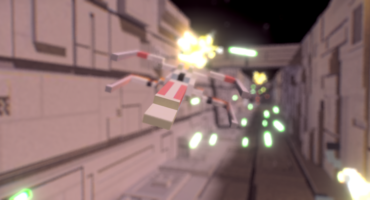Do you feel like MagicaVoxel’s 126^3 size limit is a bit too small for you? Are you dreaming of endless voxel landscapes, or mountain-tall giants? Don’t worry: here are 9 steps to join several voxel scenes from MagicaVoxel in Blender. No Blender knowledge is required at all. Just carefully follow these steps!
Preparation: Shortcuts and UI
If you get lost during the tutorial, this list of commands will be helpful enough:
To navigate in the viewport:
- Pan: SHIFT + Middle mouse button
- Orbit: Middle mouse button
- Zoom: scroll
To manipulate objects:
- Select: Right mouse button
- Translate: G
- Rotate: R
- Scale: S
You don’t absolutely need it, but it really won’t be a waste of your time to get into this Blender Basics tutorial either.
1. Export from MagicaVoxel in .Obj

In MagicaVoxel, hit Export > OBJ to export your model to your hard drive.
2. Import into Blender

- Open Blender.
- Close the splash screen by clicking anywhere.
- In the top bar, hit File > import > wavefront (.obj)
- Select the .obj file.
- The model appears – but it’s too big.
Note: Although the textures may not appear if you are in “cycles render” mode, they are indeed imported, and will show up in sketchfab. You can switch to “Blender render” to display them, but it’s not necessary.
3. Scale down the model

Select the model with a right click, hit S, then enter the value “0.1” with your numpad, then “return”.
4. Translate on one axis

With your model still selected, grab the red handle to translate it as shown.
5. Import second model

Repeat step 2 and 3 for your second model.
6. Snap to first model with vertex snapping

Change the snapping mode to “vertex”

With your second model still selected, hit G to move it, and press and hold CTRL to activate snapping to vertex, then place it next to the first model.
Note: To snap to a vertex, hover the mouse over the vertex you want to snap to, while holding CTRL. If you have trouble snapping to the correct vertex, move your model with “G” to a closer position and try again.
7. Save and export to sketchfab

Before you save, Hit File > External Data > Pack all into .blend (this saves the textures inside the file.)
All you have to do now is go to Sketchfab, hit “upload”, and drag and drop your file, or simply use the Sketchfab Blender Exporter.
To learn how about the best Sketchfab settings for your voxel scenes, read my tutorial ’Publishing Voxel Designs from MagicaVoxel to Sketchfab’. For light baking and more advanced tips, see my other tutorial, Creating a 3D star wars scene in voxels.
http://sketchfab.com/models/c90ebfa50f6a4a79b2ab43e3e32319af
Thanks Elbriga!
Don’t forget to visit Elbriga’s portfolio here on Sketchfab and to follow him to receive notifications of his new work.


